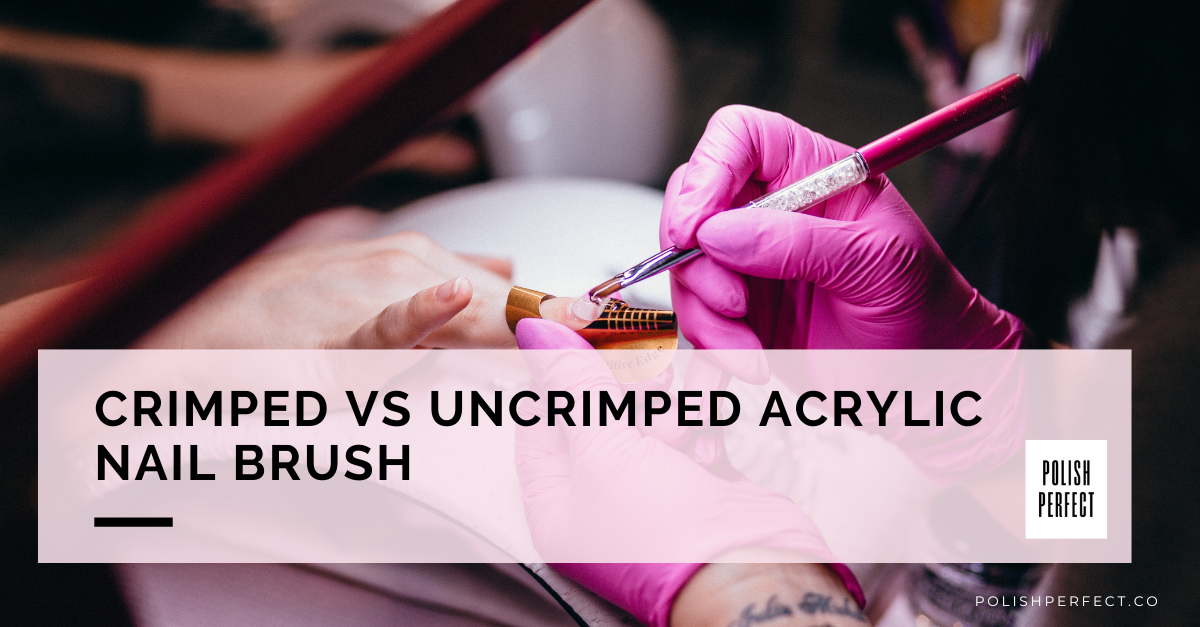Crimped vs uncrimped? Crimped brushes are known for their precision and control, which makes them excellent for detailed work. On the other hand, uncrimped brushes, with their ability to fan out, are a dream for creating full shapes or covering larger areas.
As a nail technician, your tools are your best friends.
Among these tools, acrylic nail brushes stand out.
Why?
Because they’re crucial in creating stunning artificial nails.
Choosing the right brush isn’t just a matter of preference; it’s a game-changer in your nail art technique.
Let’s dive into the world of crimped vs uncrimped acrylic nail brush and find out which one suits you best.
Understanding Acrylic Nail Brushes
Did you know there’s more to these brushes than meets the eye?
So, what exactly are acrylic nail brushes?
They are specially designed brushes used to apply acrylic powder and liquid onto the nails to create artificial nails.
The bristles, usually made from Kolinsky sable hair or synthetic materials, are designed to hold and distribute the acrylic product evenly.
Choosing the right brush depends on the technique you’re using.
For instance, a round, pointed brush might be perfect for creating precise 3D nail art, while a flat brush is ideal for standard acrylic applications.
Aside from acrylic shapes and sizes in brushes, there are also crimped and uncrimped brushes that you need to know.
Decoding Crimped and Uncrimped Brushes
The difference between a crimped vs uncrimped acrylic nail brush can significantly influence the quality of your nail art.
So, what’s the difference, and how do you choose?
(Learn more on how to crimp your acrylic nail brush here!)
Crimped Acrylic Nail Brush
Crimped brushes, as the name suggests, have a pinched metal part (the ferrule) that helps keep the bristles in a tight, pointed shape.
This feature allows for precision and control, especially when working on detailed nail art.
Uncrimped Acrylic Nail Brush
On the other hand, uncrimped brushes have a round ferrule that lets the bristles fan out more.
These are great for creating full, rounded shapes and covering larger areas.
Crimped vs Uncrimped Acrylic Nail Brush: The Pros and Cons
Now, let’s compare these two contenders.
Crimped brushes are known for their precision and control, which makes them excellent for detailed work. However, their tight bristle formation can make it challenging to cover larger areas.
Plus, they can retain more acrylic liquid, which could lead to over-saturation if you’re not careful.
Uncrimped brushes, with their ability to fan out, are a dream for creating full shapes or covering larger areas. However, they may lack the precision needed for intricate designs.
Also, they might not hold as much liquid, requiring more frequent dipping.
Choosing Your Weapon: The Right Brush for the Right Technique
Different nail art techniques require different tools.
For detailed work, such as creating intricate designs or 3D nail art, a crimped brush would be your best bet.
For applications like overlays and full sets, an uncrimped brush might do the trick.
Choosing the Right Brush for Different Nail Techniques
Every nail art technique has its own unique charm and style. From the delicate lines of striping to the bold strokes of marbling, these techniques truly make nail art a versatile canvas.
However, to achieve perfection in each of these styles, you need the right brush.
Let’s break down some of the key nail art techniques and the brushes that are a perfect match for each:
1. Striping: This technique involves creating thin, delicate lines on the nail surface. A liner brush, with its long and thin bristles, is your best bet for striping.
2. Marbling: Creating a marbling effect requires a brush that can swirl two or more colors together. A flat brush, with its wide bristles, is ideal for this.
3. Dotting: For this technique, a dotting tool is used. However, if one isn’t available, a detail brush can do the trick.
Conclusion: Crimped vs Uncrimped – Who Wins?
In the battle between crimped and uncrimped brushes, there’s no clear winner.
It all comes down to your specific needs, techniques, and personal preferences.
The key is understanding the pros and cons of each type and choosing the one that suits you best.
And remember, a brush is only as good as the artist who wields it.
So, nail techs, it’s time to choose your weapon.
Crimped vs uncrimped, which will it be?



